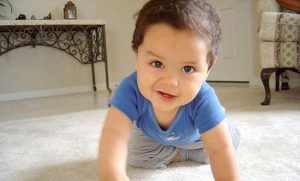Learning to crawl is a key milestone in your baby’s life.
Your baby will have already learnt to sit without support and roll; crawling is the next step. If you look at most formal developmental milestone and learning scales, you may find that crawling is left off of them. This is due to the wide range of times and methods babies may use to learn to crawl.
 When it develops
When it develops
At about six to eight months most babies will learn to balance on their hands and knees. Babies work out how to move forwards and backwards from this position by pushing off with the knees. However some children never crawl because they get comfortable with some other method of locomotion. Instead they bottom shuffle, slither on their tummies or go straight to walking. It does not matter how your baby gets around, it is getting mobile that is important.
How it develops
Over the next couple of months, your baby gradually learns to move confidently from a sitting position to being on all fours, and she soon realizes she can rock back and forth when she’s got her limbs straight and her body parallel to the floor.
Somewhere around 9 or 10 months, she’ll figure out that pushing off with her knees gives her just the boost she needs to get mobile. As she gains proficiency, she’ll learn to go from a crawling position back into a sitting position. She’ll also master the advanced technique of cross-crawling: moving one arm and the opposite leg together when she moves forward, rather than using an arm and a leg from the same side. After that, it’s just a matter of practice making perfect — look for her to be a really competent crawler by the time she’s a year old.
If your baby crawls backward, is a bottom shuffler (scoots around on her posterior using a hand behind her and a foot in front of her to propel herself), or skips the crawling stage in favour of walking, don’t worry. As long as she’s getting mobile — no matter how she does it — she’s fine.
What’s next
Your role
A crawling baby can get into a lot of mischief. Make sure your house is childproofed, and your baby has a soft, safe environment in which to hone her new skills. High places, buckets of water, open windows and balconies of high-rise apartments, and staircases are danger spots that attract crawling and walking babies.
Ensure the floor is swept clean — you wouldn’t want stray objects such as broken glass, soil from indoor plants, splinters or small toys to hurt her when she crawls. Also, ensure that there is no water or any other liquid spilled on the floor as your baby may slip. Follow standard childproofing guidelines and never leave your baby unattended, in case she falls or needs your help.
Put a special emphasis on stairway gates. Your baby will be drawn to stairs like an explorer to Mount Everest, but they can be dangerous, so keep them off-limits until your baby has really mastered this skill (usually at about 12 months) — and even then, supervise her expeditions.
Ensure that your baby’s clothes do not restrict her movements and do not forget to wash her hands and feet after she has spent time on the floor. At this stage, many babies are teething as well and they tend to frequently put their hands in their mouth.
You don’t have to invest in shoes just yet. Your baby won’t need to wear footwear regularly until she’s mastered walking.
Let your baby spend as much time as possible on the floor — don’t be over protective by carrying your baby or hovering around her around all the time. Crawling, walking, jumping and even the art of getting up after a fall are all important milestones for your baby’s growth and development so do allow her space to explore.
You can further strengthen and soothe her leg muscles by giving regular massages with any oil of your choice such as olive, mustard, almond or coconut oil.
When to be concerned
Babies develop skills differently, some more quickly than others, but if your child hasn’t shown an interest in getting mobile by some means (whether it’s creeping, crawling, rolling, or scooting), worked out how to move her arms and legs together in a coordinated motion, or learned to use both arms and both legs equally by the time she’s a year old, bring it up at your next doctor’s appointment.
Keep in mind that premature babies may reach this and other milestones several months later than their peers.
Edited from Baby Center
